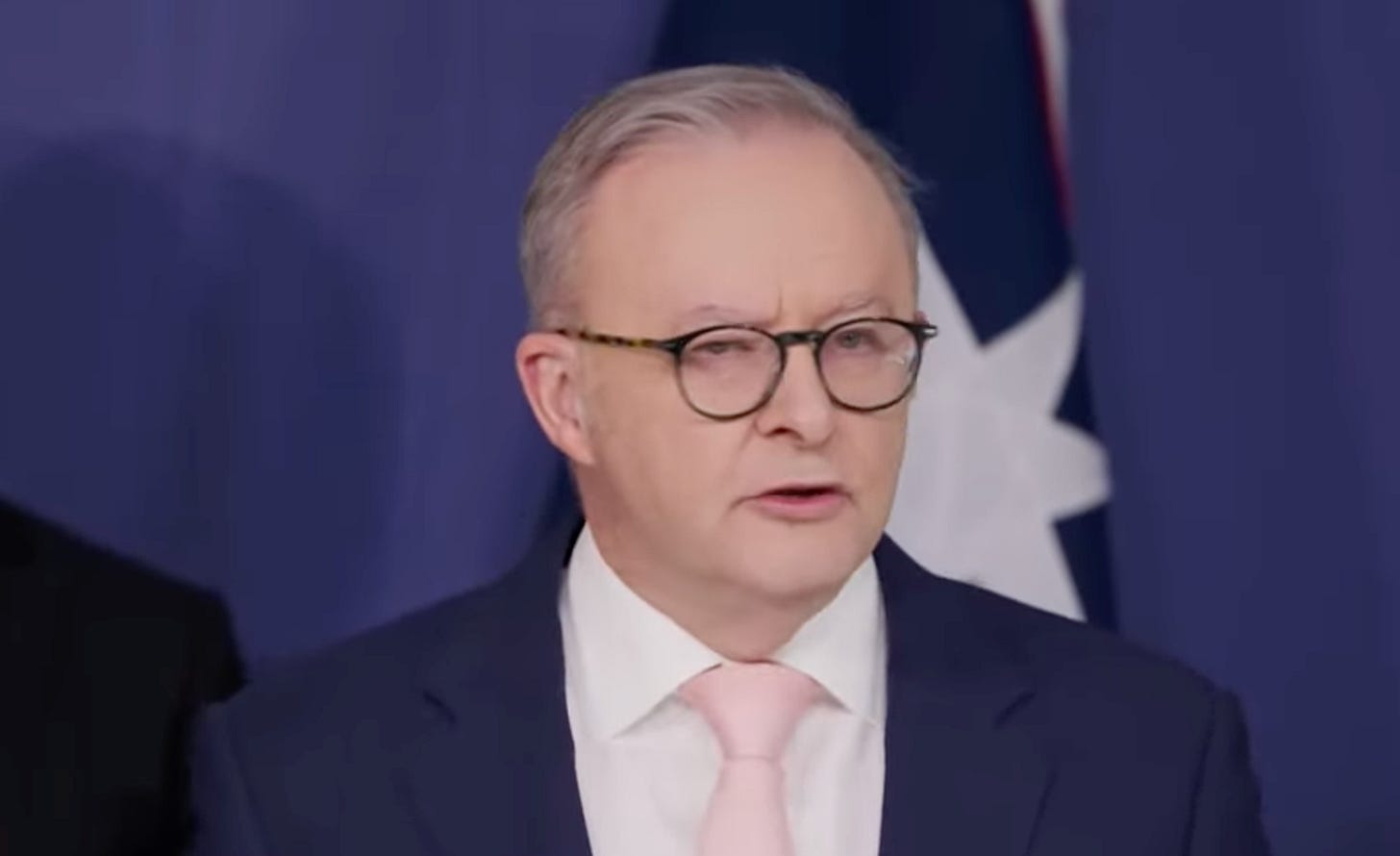Australia Sets 62-70% Emissions Target for 2035, Announces $7 Billion Investment Package
Today’s Article is brought to you by Empower your podcasting vision with a suite of creative solutions at your fingertips.
This piece is freely available to read. Become a paid subscriber today and help keep Mencari News financially afloat so that we can continue to pay our writers for their insight and expertise.
Prime Minister Anthony Albanese announced Australia will target 62% to 70% emissions reduction by 2035, unveiling a $7 billion investment package to drive the clean energy transition while Treasury modeling predicted massive economic benefits from an orderly shift to net zero.
Speaking in Canberra after Cabinet and Labor caucus meetings, Albanese said the government accepted independent advice from the Climate Change Authority that the target range represents the maximum achievable emissions reduction based on scientific and economic analysis.
"Today I announce that we have accepted their advice that Australia's 2035 emissions target be 62 to 70 percent," Albanese said. "This is a responsible target, backed by the science, backed by a practical plan to get there and built on proven technology."
The announcement includes $2 billion for the Clean Energy Finance Corporation, $5 billion through the National Reconstruction Fund for heavy industry decarbonization, $40 million for electric vehicle charging infrastructure and $50 million for sporting club emissions reduction programs.
Truth matters. Quality journalism costs.
Your subscription to Mencari directly funds the investigative reporting our democracy needs. For less than a coffee per week, you enable our journalists to uncover stories that powerful interests would rather keep hidden. There is no corporate influence involved. No compromises. Just honest journalism when we need it most.
Not ready to be paid subscribe, but appreciate the newsletter ? Grab us a beer or snag the exclusive ad spot at the top of next week's newsletter.
Treasury Modeling Shows Economic Upside
Treasurer Jim Chalmers released Treasury modeling showing Australia's economy could be $2.2 trillion larger by 2050 under an orderly transition scenario, with $36,000 more wealth per person, 5.1 million additional jobs and 80% higher investment levels.
"An orderly transition to net zero is a golden economic opportunity for Australia and the Treasury modeling that we are releasing today makes that abundantly clear," Chalmers said. "This is a huge economic opportunity for our country and its people and we would be mad not to grasp it."
The modeling compared three scenarios, with a "disorderly transition" that delays action until the 2040s resulting in an economy $1.2 trillion smaller than the baseline scenario, along with lower wages and higher electricity prices.
"Under the disorderly transition there would be lower wages and higher electricity prices as well," Chalmers said, noting that abandoning net zero entirely would be even worse for the economy.
The Treasury analysis reached five key conclusions: Australia benefits from decisive climate action, cheaper clean energy improves competitiveness, credible action means more jobs and higher living standards, orderly planning provides business certainty, and disorderly transitions damage economic outcomes.
Climate Authority Recommendations
Climate Change Authority Chairman Matt Keane said the target range resulted from extensive consultation including over 500 submissions and 560 meetings and events, combined with scientific analysis and bottom-up economic sector modeling.
"The work that the authority has established clearly and undeniably is that Australia's clean energy transition is an economic growth opportunity, not a drag," Keane said. "There is a path that will deliver benefits and savings, not costs."
Keane emphasized the target requires Australia to halve emissions over the next decade while positioning the country as a global leader on climate ambition compared to other advanced economies.
"This target requires Australia to cut its emissions by half over the decade. It's ambitious, but it's absolutely feasible," he said. "Today's report is ambitious for Australia. It's ambitious for a prosperous future that places Australia's people and Australia's industries in the driver's seat."
Implementation Strategy
Energy Minister Chris Bowen outlined how the government will achieve the targets through three primary areas: electricity generation, transport and heavy industry emissions reduction.
"The global shift to clean energy is the biggest economic transformation since the Industrial Revolution, and it presents Australia with our best ever economic opportunity," Bowen said. "If we get it right, if we make the right investments at the right time, we can grow our economy and create good jobs for Australians."
The plan builds on existing policies including the safeguard mechanism and new vehicle efficiency standards, both subject to legislative reviews next year. Since May 2022, Australia has added over 18 gigawatts of renewable capacity, with wind and solar capacity up 45%.
Albanese noted that 1,000 home battery systems are being installed every weekday across Australia, demonstrating public embrace of clean energy technology.
"A typical solar panel today is almost 10 times more powerful than it was 20 years ago and almost 10 times cheaper," he said, explaining household adoption of renewable technology.
Target Range Justification
The 62% to 70% range reflects technological uncertainties over the next decade and the need for coordinated action across all levels of government, according to Bowen.
"It reflects that technologies do change over a decade in ways that not everyone can easily predict 10 years out, and we recognize that," he said. "Solar and batteries, costs have fallen dramatically. Green hydrogen is facing international headwinds. All that will change over the next decade."
The range also acknowledges that achieving higher targets requires participation from state governments, local councils, businesses and households beyond federal government control.
"This is a whole country effort. And we hold many levers in the federal government. And we're pushing those levers. But it's a whole country effort," Bowen said.
International Comparisons
The target range aligns with international commitments, with Albanese noting the European Union is considering a 63% to 70% range over similar timeframes, while Brazil has an 8% range and Singapore a 12% range for their climate targets.
The Intergovernmental Panel on Climate Change recommended approximately 68% global emissions reduction on 2005 levels, which falls within Australia's announced range.
"Our range positions Australia as a global leader on climate ambition. In fact, we are presenting a higher ambition than most other advanced economies," Keane said, defending the target against criticism it falls short of scientific requirements.
Economic Benefits and Job Creation
The government emphasized economic opportunities from the transition, with Chalmers highlighting that more than 1.1 million jobs have been created under the Labor government, maintaining unemployment at 4.2% amid global economic uncertainty.
"More than 1.1 million jobs created under this Labor government, the lowest average unemployment of any government in the last 50 years," he said, linking employment success to clean energy investments.
Net overseas migration has declined for six consecutive quarters to 110,000 people in the March quarter, down from 129,000 the previous year and 40% below post-COVID peaks.
Funding Breakdown
The $2 billion Clean Energy Finance Corporation recapitalization will focus on renewable energy rollout to drive down electricity prices. The $5 billion National Reconstruction Fund allocation targets heavy industry decarbonization and low-emissions manufacturing scaling.
Additional measures include $1.1 billion announced previously for clean fuels production, $40 million for curbside and fast EV charging infrastructure, and programs to expand energy efficiency tools for households and businesses.
"All these investments are important as well as new investments in energy performance and energy efficiency," Bowen said, outlining comprehensive sector-by-sector implementation plans.
Political Context
The announcement comes amid opposition criticism over energy costs and climate policy credibility. The government inherited what Albanese described as a degraded energy system, with 24 of 28 coal-fired power stations having announced closures under previous governments.
"In 2022, we inherited a national energy grid that had been run into the ground," he said. "Under the former government, they announced 23 different energy policies and didn't land one of them."
The target range drew mixed reactions, with some environmental groups arguing it falls short of scientific requirements while business groups called for clarity on implementation costs and timeframes.
Technology and Innovation Focus
The plan emphasizes proven technologies including renewable energy backed by gas and battery storage, electric vehicle adoption, and industrial decarbonization through the safeguard mechanism.
Bowen noted Australia's natural advantages including abundant solar and wind resources above ground and critical minerals below ground, positioning the country for clean energy export opportunities.
"We have an abundance of solar and wind above the ground and a periodic table of critical minerals below the ground. And that is our key to economic prosperity," he said.
Implementation Timeline
The government will release detailed sector plans showing the most feasible decarbonization pathways beyond 2030, providing industry and investors with clearer guidance for long-term planning.
Both the safeguard mechanism and new vehicle efficiency standards face legislative reviews next year, with potential modifications based on performance assessments.
The target announcement fulfills Australia's commitment under the Paris Agreement to set 2035 emissions reduction goals, complementing existing 2030 targets and 2050 net zero commitments.
Albanese concluded the announcement by emphasizing the economic imperative of climate action amid global transformation.
"We are part of what is a global transformation that is occurring. We need to do our part, but of course we know that the world has to act as well," he said, noting China's massive renewable energy construction program as evidence of worldwide clean energy momentum.
The government will continue defending the target range as ambitious yet achievable while addressing implementation challenges across electricity, transport and industrial sectors over the next decade.
Sustaining Mencari Requires Your Support
Independent journalism costs money. Help us continue delivering in-depth investigations and unfiltered commentary on the world's real stories. Your financial contribution enables thorough investigative work and thoughtful analysis, all supported by a dedicated community committed to accuracy and transparency.
Subscribe today to unlock our full archive of investigative reporting and fearless analysis. Subscribing to independent media outlets represents more than just information consumption—it embodies a commitment to factual reporting.
As well as knowing you’re keeping Mencari (Australia) alive, you’ll also get:
Get breaking news AS IT HAPPENS - Gain instant access to our real-time coverage and analysis when major stories break, keeping you ahead of the curve
Unlock our COMPLETE content library - Enjoy unlimited access to every newsletter, podcast episode, and exclusive archive—all seamlessly available in your favorite podcast apps.
Join the conversation that matters - Be part of our vibrant community with full commenting privileges on all content, directly supporting The Evening Post (Australia)
Catch up on some of Mencari’s recent stories:
It only takes a minute to help us investigate fearlessly and expose lies and wrongdoing to hold power accountable. Thanks!








